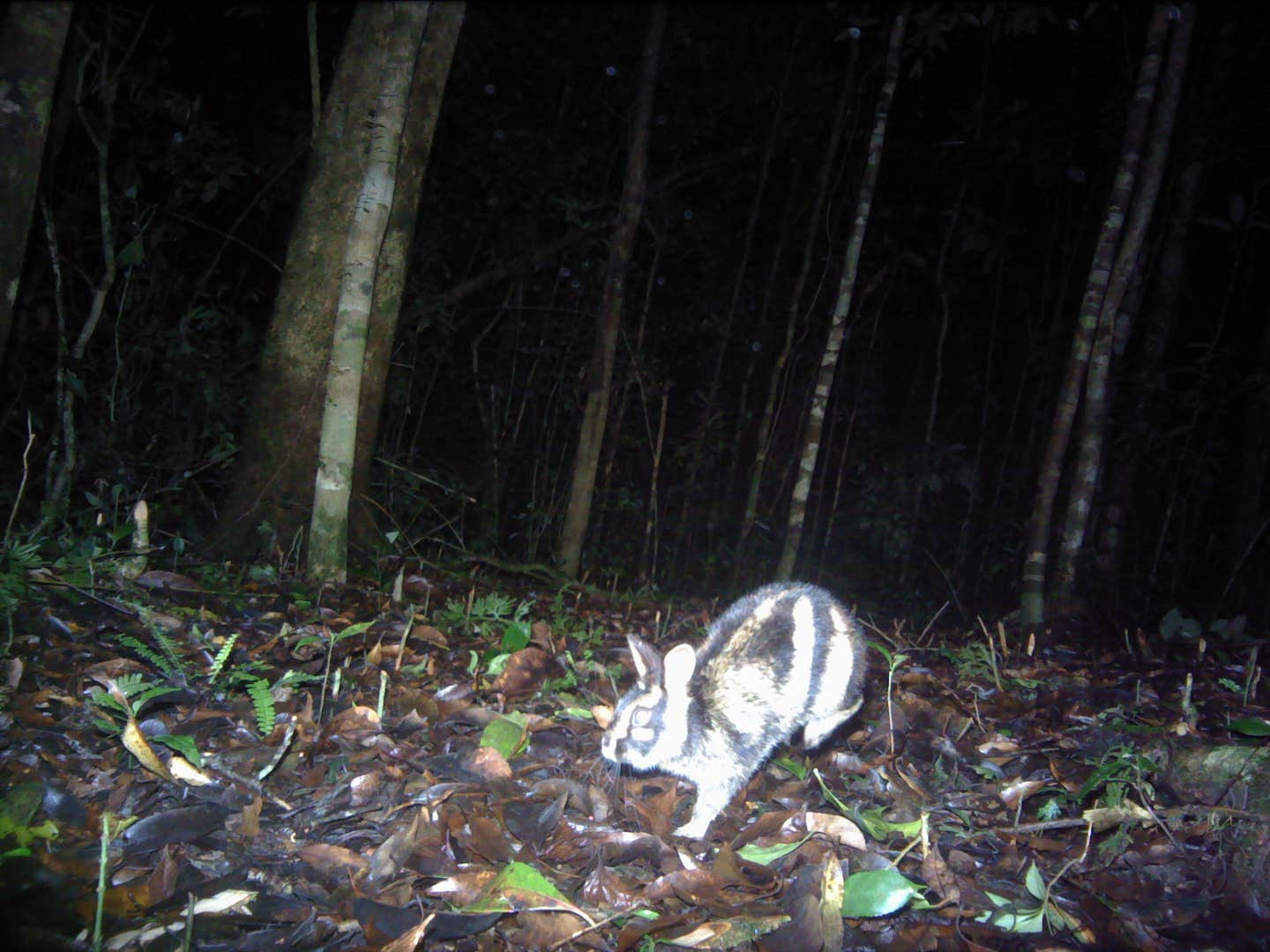When field biologist An Nguyen began his PhD research studying mammals in the southern part of the Annamites, a mountain range that runs along the border of Vietnam and Laos, he wasn’t sure what he’d find. Decades of unsustainable hunting have taken a massive toll on Vietnam’s wildlife, including big cats, large ungulates and virtually all of the country’s large carnivores.But as Nguyen, a PhD student at the Leibniz Institute for Zoo and Wildlife Research (Leibniz-IZW) and Re:wild conservation associate, reviewed camera-trap images, he spotted something surprising. He soon confirmed that his camera trap had documented a rare Annamite Striped Rabbit (Nesolagus timminsi) in Bidoup Nui Ba National Park — more than 300 kilometers south of the species’ nearest known habitat.
Illuminating an elusive species
Although the Annamites are a small mountain range, they are home to many endemic mammals found nowhere else on Earth — including a wild cattle species called the Saola, several muntjac deer species and the Annamite Striped Rabbit.
Surprisingly the rabbit was unknown to scientists until the mid-1990s, when a dead specimen was found for sale at a Laotian market. With its short ears and legs and striped back, the species was later found to be most closely related to the Sumatran Striped Rabbit (Nesolagus netscheri) — although the two species diverged 8 million years ago.
The Annamite Striped Rabbit was officially described in 2000, “and since then virtually nothing has been published about it,” says Nguyen. “So for the past few years, we have been doing surveys up and down the Annamites and gathering data on this species, and we’re still just getting little glimpses into its ecology and its distribution.”
The species was recently reclassified from Data Deficient to Endangered on the IUCN Red List of Threatened Species. Based on interviews with local people, hunter records and camera-trap evidence, scientists knew that the species occurred in narrow pockets of wet evergreen forest in the northern and central Annamites. Its discovery at this new location in the southern Annamites expands the known range.
“This distance might not sound like much, but for an area as small as the Annamites, it’s pretty remarkable” says Andrew Tilker, Re:wild’s Asian species officer and the lead author of the recent IUCN Red List reassessment. “Nobody thought that the species would turn up there!”
A snaring ‘crisis’
Compared to many other tropical forested countries, Vietnam has been relatively successful at stemming deforestation in recent years. But while forest cover remains relatively intact, wildlife faces a more direct threat.
“There’s far more forest than there are animals to live in the forest,” Tilker says. “There are entire protected areas that are basically empty of wildlife. Even things like squirrels are getting rare, because unsustainable hunting pressure is so high. The Annamites are in the midst of a snaring crisis.”
Although few in Vietnam still practice subsistence hunting, it’s a common practice for people to set snares and sell the animals they catch to supplement their income. “It’s really a problem,” says Barney Long, Re:wild’s senior director of conservation strategies. “There’s an enormous demand for wildlife meat in restaurants and local markets throughout Vietnam.” A few species such as pangolins may be exported, but most — including the rabbit — are likely consumed locally.
Historically, the Annamite Striped Rabbit would have played a crucial role at the bottom of the forest food chain. But due to the snaring crisis, humans are now its most threatening predator.
Next steps for conservation
“We were very, very surprised when we found the species in the far south,” Nguyen says. The species’ discovery in the southern mountains could help revitalize and target conservation efforts there.”
Duy Le, a researcher at the Southern Institute of Ecology who was involved in the study, adds “This new finding made me think first that there must still be some unknown information on the wild animal's populations in the remaining forests in Vietnam, especially in the southern Annamites which is considered the hotspot for high biodiversity in the Indochina region. . . Then I thought, we need to take more actions now.”
The staff of Bidoup-Nui Ba National Park, where the rabbit was spotted, is keen to do so. “For the next step, we will conduct extensive surveys with our partners to investigate the trend of conservation status of the Annamite striped rabbit and which ecological factors are driving the occurrence of this species,” says Dr. Le Van Huong, the park director.
Together with core partners including WWF, Bidoup Nui Ba National Park, the Leibniz-IZW, and the Southern Institute of Ecology, Re:wild is supporting systematic camera trap surveys. “If we find very rare species — the striped rabbit or other things — in certain areas, then we can focus snare removal in those areas,” Tilker says. Dr. Huong agrees, saying. “By targeting protection efforts, we can better protect the rare species that make places like Bidoup so special.”
In other parts of Vietnam where the Annamite Striped Rabbit occurs, WWF employs community members as forest guards, who remove snares from the forest among other duties. Given limited resources for snare removal and other conservation activities, knowing where to target snare removal can help use those resources more efficiently.
Camera trapping will also help researchers assess species population changes over time. “We want to know if what we’re doing as conservationists is working,” Tilker continues, “if ultimately it’s helping stabilize species declines and hopefully even increase populations. And so having a baseline camera trapping for all animals, including the striped rabbit, allows us to assess population trajectories in the future by repeating that sampling and understanding population trends.”
Right now, the species’ fate is uncertain. “It’s a tragedy that the last tigers are gone from Vietnam,” Nguyen says. “But if striped rabbit were to be lost from the Annamites, it would be a catastrophe, because the species doesn’t exist outside this pretty small mountain range. If they disappear from this area, they will disappear forever.”
Still, finding this rare species in an unexpected place is a spark of hope for Vietnam’s wildlife in a country that needs more conservation success stories — and an illustration of how much we still don’t know about the world’s tropical forests and the life they hold.

Molly Bergen
Writer
Since beginning her career as a zookeeper, Molly Bergen has spent more than 16 years telling stories for a range of environmental NGOs. Covering everything from turtle nest guardians in Cambodia to community forests in the Congo, she is particularly passionate about conservation projects that create a “win-win” for both species and local people.



